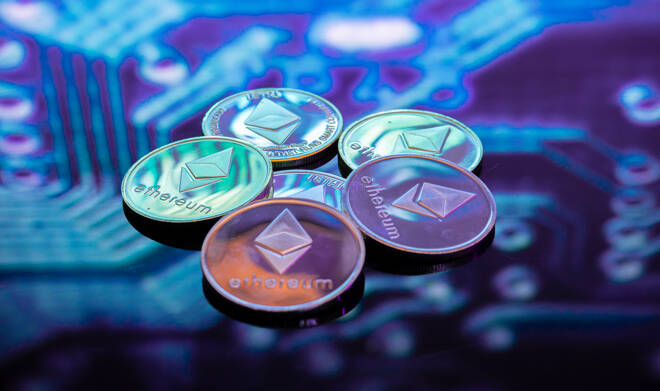Advertisement
Advertisement
Is It Time to Go Long Ethereum, or Should You Wait?
Published: Apr 28, 2022, 18:44 GMT+00:00
The best way to help assess the trend of ETH, and any asset class for that matter, is to look at where its price is in relationship to several moving averages (SMAs) and, in this case, the Ichimoku Cloud.
Ethereum Technical Analysis
Although I primarily use the Elliott Wave Principle (EWP) to keep my premium crypto trading members abreast of where Ethereum (ETH) should top or bottom, one should never use any tool in a vacuum and apply other metrics to help assess if it is time to go long or not. Maybe even when to short it.
The best way to help assess the trend of ETH, and any asset class for that matter, is to look at where its price is in relationship to several moving averages (SMAs) and, in this case, the Ichimoku Cloud. See Figure 1 below.
Figure 1. ETH daily chart with simple moving averages (SMAs) and Ichimoku Cloud.
Trend Analyses for Trading
If ETH is trading above its rising SMAs and above the Cloud, like during most of last year, we know the trend is bullish, up, and dips should be bought until the trend ends, like in May and November 2021. See also here. Conversely, when ETH is below its SMAs, especially the 200d SMA (in red in Figure 1) and the Cloud, the trend is Bearish, down, and one should be much more conservative when buying dips, trade smaller, have tighter stops, and take profits quicker.
It also means in Bull markets, one’s entry can be less precise, not that it should, as eventually, the price of ETH will go up anyway, and you’ll make your money. Or, as they say “in a Bull, everyone is a hero.” Therefore, Bear markets separate the professionals from the amateurs as they require precise entries and exits to not lose all your hard-earned money.
The trend is your friend chart can help you. The traffic light in the upper left corner in Figure 1 can be either green or red. In the former case, ETH is Bullishly trending; in the latter case Bearishly. Currently, the Traffic Light is red: ETH is below its SMAs and the Cloud. Thus one should be (very) cautious on the long side and maybe even forego buying ETH until the trend is more friendly and provides Low Risk (LR) entries.
Therefore, current buying is High Risk (HR), especially since the SMAs are bearishly stacked: the 10d SMA is below the 20d< 50d SMA< 200d SMA. Not friendly. Therefore, it may be better to forego a 20% rally to have a more favorable trend that can provide an LR entry and possible triple-digit gains, similar to the summer and fall of last year. Indeed, good things take time, and patience gets rewarded.
Lastly, a simple price chart like in Figure 1 can provide us with crucial breakout levels that ETH needs to clear to establish a new bullish trend. The first level, at ~$3000, is an HR entry. The 2nd level at ~$3200 is Medium Risk (MR), and if ETH can clear the 200d SMA, any buying is considered LR. Note, nowhere does it say “No Risk.” There’s always risk involved, so please also place stop losses accordingly to protect your money if the trade goes south. With high risk comes a higher reward and a higher chance of a failed trade, so please always trade according to your risk appetite.
Bottom Line
Ethereum is in a Bearish downtrend and should be traded accordingly. Knowing the trend can help tremendously in determining A) how to trade and B) what the chances are for a successful trade. Having that information available is professional trading.
About the Author
Dr. Arnout Ter Schurecontributor
Dr. Ter Schure founded Intelligent Investing, LLC where he provides detailed daily updates to individuals and private funds on the US markets, Metals & Miners, USD,and Crypto Currencies
Did you find this article useful?
Latest news and analysis
Advertisement
